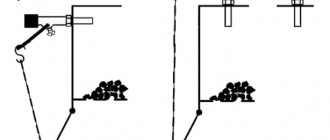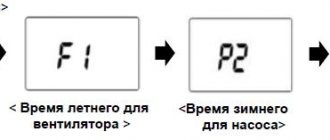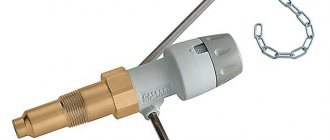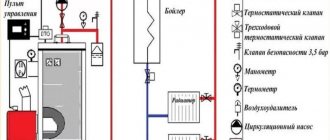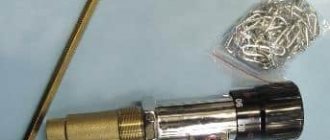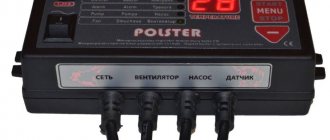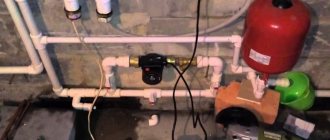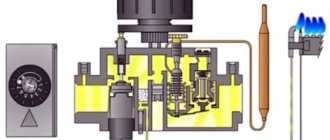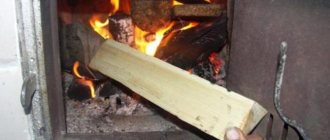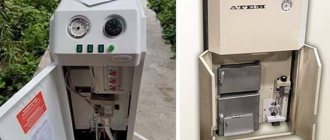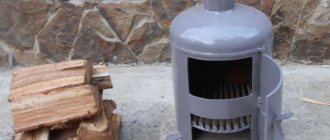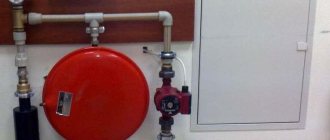Home / Solid fuel boilers
Back
Published: 05/25/2019
Reading time: 2 min
0
6261
In the recent past, the rate of fuel combustion in solid fuel heating units could only be adjusted manually. For this purpose, there was a ash door, by opening or closing which the air flow to the firebox increased or decreased.
Today, an automatic device called a draft regulator for a solid fuel boiler is successfully used for this purpose. To set the required temperature. When using it, it is enough to determine the required coolant temperature. The presented characteristics will help demonstrate the capabilities of a useful invention for the home.
- 1 Why do we need draft regulators?
- 2 Operating principle
- 3 Types of regulators, and which ones are better
- 4 How to install and configure the regulator
Why are regulators needed?
Unlike any wood-burning stove, a hot-water solid fuel boiler is equipped with a water jacket and cannot heat up to too high a temperature, otherwise the water in it will simply boil. In such cases, the resulting steam sharply increases the pressure in the system, causing an explosion. That is, a solid fuel boiler, whose power is manually regulated by the ash pan door, is a source of increased danger.
Note. At the very least, the boiler, without any automation, can work together with a buffer tank - a heat accumulator, whose volume is correctly calculated. Excess heat will go there if you did not close the door in time and did not limit the flow of air into the firebox.
An automatic chimney draft regulator, which you can install on any solid fuel boiler yourself, will supply air for you and much better than you. It will react in time to an increase in the temperature of the water in the boiler jacket and shut off the air supply to the chamber if the firewood gets very hot. Although, by inertia, the temperature will rise for some time, but in general the heating process will stop. In addition to ensuring safety, a mechanical boiler draft regulator helps solve the following issues:
- Does not allow the coolant temperature set by the user to be exceeded. It is not always necessary to accelerate the boiler to 80...90 °C; in spring or autumn, 50...60 °C is quite enough for heating.
- By covering the damper and air supply, the draft regulator increases the burning time of the boiler from one tab. But we must admit that the fuel combustion conditions worsen, and the efficiency of the heater sharply decreases.
Almost any solid fuel boiler can be equipped with 2 types of temperature controllers - mechanical (on the left in the photo) or electronic (on the right).
You can argue that any solid fuel heat generators should be connected to the heating system using a safety valve set to emergency pressure. If it overheats, the valve will work, release steam and no explosion will occur. So the draft regulators seem to be of no use. The statement is only partly true, since without automation the heater will often reach a critical temperature, and the valve will simply leak after 2-3 operations. Yes, and controlling the water temperature manually is quite difficult.
Make it yourself or buy it
The design of the stabilizer is quite simple, and you can easily make it yourself, although adjusting the traction with purchased products is a little more accurate. For ready-made modern pipes assembled from modular elements, it is easier to choose a device from the same manufacturer; for homemade bathhouse and garage stoves, you can make the stabilizer yourself - there is simply no point in purchasing a branded product.
Trusted manufacturers
Not all companies that produce chimneys also produce draft stabilizers. The situation is even more complicated when looking for a stabilizer for pipes made of brick or asbestos cement. If you are installing a purchased modular chimney, ceramic or sandwich, then it makes sense to buy components from the same company. In addition, in the outback, pipes of one or two brands are most often offered for sale, and there is practically no choice.
You can often hear praise for the Polish manufacturer - Darco; stabilizers are also produced by KRAFT (Voronezh), ZKZ-INDUSTRI (Czech Republic), POLMAR (Poland); SWaG (Ukraine); On the Internet you can find the Afriso brand, the Kiev brand Trio-Trade (Lux Version).
approximate price
I will provide information on how much a traction stabilizer costs:
- for chimneys with a diameter of 100 mm
- diameter 150 mm
- diameter 200 mm
How to make a draft regulator with your own hands
It’s up to you to make a compensator yourself or buy a ready-made one. For convenience, it is worth making a drawing with exact dimensions. You can prepare patterns from whatman paper and use them to cut out parts from a metal sheet.
Design and principle of operation
The device diagram is quite simple. The main structural elements are:
- temperature control handle;
- rod and guide;
- actuating mechanism;
- immersion sleeve;
- temperature sensitive element;
- spring;
- drive lever;
- handle and lever mounting screws;
- chain.
The main component is a sensor that responds to temperature fluctuations. It interacts with a spring, which, when heated or cooled, activates the working part (sleeve and rod).
That, in turn, is connected through a mechanical drive to the fuel compartment flap. The draft regulator for solid fuel boilers, under certain conditions, opens and closes the door, maintaining the set temperature.
The principle of operation of the device is banal, but still effective. When the damper opens slightly, more air enters the firebox. Due to this, fuel combustion occurs more intensely, more heat is released, and the room is heated more efficiently. When the valve closes, the fuel is less supplied with oxygen and barely smolders.
If we briefly describe the operation of the draft regulator, based on design features, we get the following diagram:
- when the heat load decreases, the thermostatic sensor reacts to fluctuations;
- the sensor increases the spring tension;
- the spring lifts the lever;
- the damper opens;
- the combustion intensifies.
To reduce the intensity of the process, the steps are performed in reverse order.
The regulator body has a handle with a temperature scale. This sets the required minimum value. The temperature will rise as necessary, but will never fall below the set level.
On the regulator body there is a handle with a temperature scale, so the required minimum value is set.
Types of thermostats
Based on the type of functions, they can be divided into several groups:
— with one function (temperature maintenance);
Thermostat with one function
- with a large number of functions (programmable).
Programmable temperature controller
Based on their design, thermostats are divided into types: wireless and with wires for communication with the boiler. Install the thermostats in a convenient place, connect the temperature sensor, connect it to the boiler control system and use it.
Room thermostats need a constant flow of air to function properly and properly, so they should not be covered with curtains or blocked by furniture. Devices adjacent to the electric thermostat may interfere with the correct operation of the device: lamps, televisions, heating devices located nearby.
How to install and configure the regulator
To install the draft thermostat, it is necessary to free the boiler jacket from the coolant; for this purpose, as a rule, special taps are provided in the unit piping that cut off the circuit with the heating element. Otherwise, you will have to drain the entire volume of the system.
The next step is to remove the plug from the sleeve on the boiler, and install the prepared device in its place. After this, the system is filled with water again. To set up the draft regulator, you need to start the boiler for heat and perform a series of sequential actions.
- Open the damper to fully supply air to the firebox. In this case, the chain should not be connected yet.
- It is necessary to loosen the fixing screw on the adjustment handle.
- Select the position corresponding to the required temperature, for example, 70°.
- Noting the heating with a thermometer, connect the chain to the damper when the coolant reaches a temperature of 70°. The damper, in this position, should leave the hole open by only 2 mm.
- Finally, the fixing screw is tightened again.
After the structure is assembled, the draft regulator is checked in different operating modes from maximum to minimum. You should pause for the difference between reaching the set temperature and the moment the lever is activated, because firewood is not a gas and extinguishes smoothly. For this reason, you should not rush to set up the device again without pausing. After passing all checks, the installation of the draft regulator is considered completed.
We recommend: Calculation of heating radiators, number of sections and battery power
A heterogeneous and complex concept that includes several factors is traction force. This parameter must be at the highest level in order for the device to operate stably. The way energy is generated and fuel is burned is influenced by the standard deviation of traction force indicators. Most often, owners of solid fuel boilers encounter this problem if there are irregularities in installation work. Prudent people purchase a draft regulator along with the equipment in order not to encounter such a problem.
Central thermostat
This thermostat is located far away from your boiler and usually allows you to turn the heating on or off throughout the house. Older versions are connected by wires to the boiler; newer systems tend to send signals to the device's command post. It is the new type of devices that are equipped with quite expensive but effective appliances: double-circuit boilers Ferroli, Beretta and domestic AOGV.
The most famous are room thermostats for double-circuit boilers of the Gsm and Protherm brands. They have a built-in dilatometric thermostat for the boiler, which, depending on the model, can operate remotely; this technology is often used for an electric boiler or solid fuel units.
The room thermostat turns off the heating of the system as needed. It works by measuring the air temperature, turning on the heating when the air temperature drops below the thermostat setting, and turning it off when the set temperature is reached.
Adviсe:
- It is recommended to set the thermostat to 20°C;
- At night, the set temperature should be between 19-21° C.
- It is advisable that the temperature in the children's room is about 22 ° C.
- The temperature should not fall below 22°C in rooms for elderly and disabled people.
As a rule, the temperature of the entire house or individual rooms is based on only one climate microcontroller in the heating system. The best option is to place it in the living room or bedroom, which should probably be the most visited place in the house.
Room thermostats need free air flow to measure temperature, so they should not be covered with curtains or blocked by furniture. Devices adjacent to the electric thermostat may interfere with the correct operation of the device. These include lamps, TVs, neighbors' boilers through the wall, touch switches.
Traction regulator functions
The main task will become clear if you look at the name of the device. If you do not regulate the temperature of the coolant (water jacket), it will simply boil. Without an automatic regulator, you will either have to constantly add liquid or manually control the flow of air entering the firebox.
The traction regulator greatly simplifies the life of private home owners. In addition to control, it performs two more useful functions:
- setting and maintaining the maximum permissible water temperature without boiling (up to 90° C; this is especially true in autumn or early spring);
- fuel economy (when the damper is closed, the intensity (speed) of firewood combustion decreases (albeit due to a decrease in boiler efficiency)).
Installing a draft regulator on a solid fuel boiler involves certain costs. To save money, some use a safety valve for similar purposes. For some reason it is considered an analogue of a regulator.
The solution is not the most rational, since after only 3-4 operations (turning off the boiler if there is a risk of overheating and reactivating it if there is excessive cooling), the accessory begins to leak.
Self-regulation of the heating system: review of devices and techniques
When designing a heating system, measures must be taken to control temperature and pressure. To do this, it is necessary to install special fittings and devices. How to properly adjust the heating system: radiators, pressure and other elements? First you need to understand the principles of organization of these sections of the system.
- Heating control methods
- Regulating the heating of a private house
- Stabilization of pressure in the heating system
- Adjusting the expansion tank
- How to adjust a security group
- Mayevsky crane
- Heating temperature control
- Mixing units
- Servo drives
- Tips for adjusting heating
How does the draft control work?
The main part of the air regulator is a mechanical thermoelement placed in a cylindrical housing. Through a lever and a chain, it regulates the rise of the air damper on the ash pan door.
The device is a sealed flask filled with a heat-sensitive liquid that expands greatly when heated. The flask stands inside the housing, which is screwed into the sleeve of the boiler's water jacket and is in contact with the coolant. How a thermostat with a chain drive works is shown in the diagram:
The operating principle of the automatic draft regulator is based on controlling the flow of air flowing into the firebox under the influence of chimney draft. The algorithm looks like this:
- When solid fuel burns and the coolant heats up, the liquid inside the element expands and acts on the actuator and lever, overcoming the elastic force of the spring.
- The lever weakens the chain, the valve begins to close and reduce the flow area. Less air enters the firebox, and the combustion process slows down.
- The temperature of the water in the boiler tank decreases, the liquid is compressed and the return spring forces the lever to open the damper again through a chain.
- The cycle is repeated until the wood in the firebox is completely burned out, then the spring opens the door as wide as possible.
The draft limiter works on the opposite principle - the higher the water temperature in the boiler tank, the more the damper closes. The adjustment handle at the end of the thermostat serves to limit the stroke of the lever and, accordingly, the air damper. This sets the maximum coolant temperature.
Reference. In addition to mechanical regulators that do not depend on electricity, there is automation for solid fuel boilers with a controller and a blower fan (or smoke exhauster). The latter supplies air to the firebox at the command of the electronic unit, which is guided by the signals from the temperature sensor. Similar automation kits are installed on all pyrolysis and pellet boilers.
Principle of operation
The main role in the design of the draft regulator is played by a thermostatic element located inside a cylindrical body. It has a mechanical connection with the lever, which, in turn, is attached by a chain to the vent flap.
The thermostatic element is presented in the form of a sealed flask, which is filled with a heat-sensitive liquid that has the ability to expand under the influence of temperature.
The element itself is located in the lower part of the housing, which, when installed, falls inside the jacket and has direct contact with the heated coolant. Control of fuel combustion, in this case, is carried out by adjusting the position of the ash valve.
- During the combustion of fuel, the coolant is heated, which acts on the thermostatic element. This, in turn, overcomes the resistance of the return spring and activates the actuator.
- Lowering, the lever loosens the chain, the detached damper lowers, reducing the cross-section of the air supply opening. When the air flow to the firebox is reduced, the combustion process slows down.
- When the temperature of the coolant decreases, all actions occur in the reverse order. As a result, the damper rises, resuming the flow of air to the firebox.
- The cyclical adjustment of the air flow to the firebox occurs continuously until the fuel is completely burned. In this case, the thermostatic element completely releases the return spring, which opens the air supply valve as much as possible.
At the end of the thermostat there is a setting handle that can limit the amplitude of movement of the lever, regulating the movement of the damper. This allows you to control the temperature of the coolant. The operating principle of a gas boiler does not allow the use of these devices.
Electronic regulators for TT boilers
An electronic thermostat for a solid fuel boiler works on the mechanical principle, but with certain differences:
- Microprocessor automation for solid fuel boilers is connected to remote thermostats located in heated rooms.
- The damper is opened electrically.
- The automation is simultaneously connected to devices to improve traction. When the temperature drops, the ash pan damper opens and the blower fan turns on, promoting rapid heating of the coolant.
A microprocessor controller for maintaining the set temperature in a solid fuel boiler quickly responds when a signal is received that the coolant is overheating. The error in the settings is no more than 1°C.
How does electronic automation work?
The automation is connected to remote sensors for recording temperature readings in rooms. Unlike a mechanical controller, it is not the coolant heating indicators that are read, but the intensity of air heating in the rooms.
The operating principle of the electronic traction control is as follows:
- Room temperature sensors transmit a signal to the boiler automation unit.
- The microprocessor reads the received signals and transmits commands to the electric drive.
- The electric drive is connected to a chain connected to the damper.
- The motor pulls the drive, opening and closing the damper to the required distance.
- Additionally, the automation unit for the water-heating solid fuel boiler is connected to fans that pump air, a circulation pump (installed in some models) and an automatic fuel supply system.
The boiler automation is connected to a programmable thermostat. Modern models of devices are weather-sensitive, which makes it possible to take into account not only the internal microclimate of the room, but also the ambient temperature. The automatic control is connected to the fan of the solid fuel boiler, which allows you to ignite the fuel faster and more accurately regulate its operation.
No adjustment of the automatic draft control is required. Unlike its mechanical counterpart, the automation adapts to the operation of the boiler.
Installation of a long-burning boiler
For indoor use, the long-burning boiler option from the NewTerm company was chosen. The boiler power is 64 - 79 kW, according to the characteristics declared by the manufacturer. The height of the boiler is just over 1.5 meters, diameter - 0.76 meters.
Overall, the boiler is not bad. It has two hatches for operation, one for loading fuel into the combustion chamber.
The second hatch is for cleaning slag and ash, cleaning the combustion chamber from residues.
Among the disadvantages, the following can be noted:
- Poor hatch sealing system;
- The wrong metal was used to protect the hatch from overheating (the casing was too thin, and the casing “failed” at the first start);
- For boilers with a power of 50 kW or more, a more powerful fan is needed, since the blowing goes only under the grate.
- The possibility of operating the boiler with natural draft has not been thought through. There is no separate hatch or special airlock for this.
All comments on shortcomings are described in my personal opinion, and do not claim exclusivity.
After installing the boiler, we level the boiler using special balancing legs. This possibility is conveniently provided. We achieve the maximum possible horizontal and vertical “evenness” of the boiler.
In the photo above, it’s hard to see, but you can see the legs for balancing the boiler.
Advantages and disadvantages of draft regulators
These devices have both advantages and disadvantages.
We recommend: Finishing balconies and loggias of any complexity
Among the advantages are:
- Low price for devices. Their cost depends on the manufacturer and model.
- Mechanical draft regulator for solid fuel boilers - the draft regulator functions autonomously, regardless of electricity.
- Fuel for it is available.
- Works for a long time and with high quality.
There are also disadvantages:
- Fuel lasts for a short time.
- Download it yourself.
- Additional space is needed to store fuel.
If you plan to purchase a solid fuel unit, then after connecting it to the heating system, the question will certainly arise of how to configure the draft regulator for solid fuel boilers correctly, since this affects efficiency and fuel consumption. It is better to entrust this to a specialist.
Characteristics of Cooper heating boilers.
The Teplodar company is versatile. It will not be possible to highlight its main direction, because... it simultaneously produces gas-wood stoves for baths, electric heaters, universal heating boilers, electric heating boilers and fireplace stoves. And the main focus of the entire product line is not visible. But if there are questions about sauna stoves, then there are none about heating boilers. As you can see in the image, the boiler is completely covered with a water jacket, thanks to which heat is removed from all sides (in the PRO series, even from coals).
There are also two models that have hobs, although in the OVK-10 model the rings are removable. Thanks to this, you can put a cauldron on it. For small dachas, the solution is quite practical and interesting. The entire boiler is covered from the outside with basalt cardboard, which prevents the outer casing from heating.
The boiler package includes: heating element for 6 or 9 kW, depending on the power of the boiler; Thermometer; Grate; flap; Screw and poker; ash pan and doors.
Tips for choosing a device
Specialized stores have a huge selection of solid fuel boilers. And, oddly enough, even today you can find models without automation. Most of these “ancient” devices are equipped only with a sleeve mounted inside the heat exchanger. Installation of a draft regulator on a solid fuel boiler of this type is mandatory. This will prevent the temperature from rising to critical levels and will make the structure safer.
In this regard, it is necessary to pay attention to the presence in the design of a sleeve and a flap that rises upward.
When choosing a mechanized draft regulator, you must adhere to the following recommendations:
- the thermostat power must correspond to the weight of the sash in order to successfully lift it;
- it is better to choose the ability to regulate the temperature in the range from +60 to +90°C;
- the angle of rotation of the lever should be enough to fully open and close the sash;
- The threads in the boiler must match the threads of the draft regulator in order to freely fasten the two parts together.
The heating process using modern mechanized and automatic draft regulators has become easy and convenient today
When choosing a regulator, you should also pay attention to the position in which it can operate, since the sleeve can be located on the side or on top. There are models that can work in any position.
Review of manufacturers
On sale you can find thermostats for heating boilers to suit every taste. There are budget and more expensive models. And in order to choose it correctly, you need to consider the following.
- The temperature adjustment interval should be 60-90°C.
- The force specified in the design passport, which is developed by the drive, must be sufficient to lift the door.
- It is necessary to ensure that the operating stroke of the drive is sufficient to fully open and close the flap.
- The thread connection on the body must match the corresponding part in the boiler and be ¾.
The location of the draft regulator sleeve on the body of the heating boiler can be at the top, side or front. For the vertical option, you need a device that can function in a vertical position, and for the rest - in a horizontal position. Of course, there are also regulators that do not care about position and operate on two adjustment scales.
Currently, automatic draft regulators for solid fuel boilers are produced by several domestic and foreign companies. In Russia, devices most often purchased are from the Italian and Ukrainian brands “Air Auto”, the American “Watts”, and the Polish “Tech”.
It’s worth saying right away that prices for draft regulators for solid fuel boilers vary. And this is mostly influenced by the location of the manufacturer and the type of action (electronic thermostats are always several times more expensive).
For example, the Ukrainian brand “Air Auto” costs an average of 7,000 rubles, and the similar Polish brand “Tech” costs 10,000 rubles.
We suggest looking at some brands of popular regulator manufacturers in the table.
ManufacturerCountryCharacteristics
| Atos | Italy | Specializes in the production of exclusively automatic systems. Assumes manual or automatic fuel loading. Electrohydraulics involves installing a system from 15 kW. |
| Air Auto | Ukraine | Assumes manual loading of fuel. The product is provided with a control unit with several operating modes. The set includes circulation equipment, smoke exhausters, fans. A special feature of the brand is the ability to smoothly control the fan speed. During operation, an integral-differential algorithm is used, which increases the duration of fuel combustion by 20%. |
| Watts RT | America | Wide range of operating temperatures, from 30 to 100°C. The brand has a standard threaded connection and is also perfect for installation in modern boilers. |
| Tech | Poland | It mainly produces automation, which is controlled by a microprocessor. The brand has a simple design, with a basic set of functions necessary for the operation of the boiler. The modules have four operating modes and built-in protection against overheating of the coolant. |
| ICMA | Italy | This model is characterized by chain tension with a load of up to 850 g, a wide range of power settings (from 30 to 100°C) and the possibility of both horizontal and vertical installation. |
| Euroster | Poland | Offers electronic automatic thermostats that connect to room thermostats and automatically ensure the combustion process. Accurately monitors room temperature and is ideal for controlling underfloor heating systems. If desired, the heating temperature can be 30-90°C. The maximum load on the chain is 800 g. |
| ESBE | Sweden | The brand produces mechanical and electronic temperature controllers for heating boilers. The latter are intended for boilers with automatic fuel supply. The thermostat is connected to circulation equipment and blower fans. |
| Regulus RT3 | Slovakia | The “regulus” draft regulator implies an adjustment range of 30 – 90°C. 120°C is the highest temperature for heating water, 60°C for the medium. Working position horizontal and vertical. Its improved model is the regulus rt4 traction control. It is distinguished by its smaller dimensions, and, unlike rt3, its load on the chain is not 800 grams, but up to 1 kg. |
| Lemax | Italy | It has an adjustable handle made of thermosetting resin - and this is the main feature of the manufacturer. There is a heat-sensitive element, so you don’t have to worry about safety. The brand boasts of precision settings and reliability. The control equipment produced is of standard sizes, therefore suitable for many solid fuel boilers. |
| Honeywell FR 124 | Germany | Compatible with most solid fuel boilers (BURNiT, Wirbel, Viadrus Buderus, KChM, ZOTA, DON, etc.) Maximum operating temperature is 115 °C. The adjustment range of the draft regulator is 30-90 °C. The temperature-sensitive element is filled with wax. It has two scales, suggesting both horizontal and vertical installation. |
We recommend: Kiturami gas boiler: design, technical specifications, operating instructions and owner reviews
Thus, the draft regulator allows you to increase the ease of operation of the solid fuel boiler.
Boiler protection against power outage
Modern boilers and other boiler room equipment are equipped with electrical and electronic equipment to varying degrees. Circulation pumps, air blowers, electric valves, electronic control units, protection and monitoring, displays - all this equipment requires a constant supply of electricity.
Even short-term power outages disrupt the operation of the heating system. Power outages are especially painful for solid fuel boilers.
In systems with a solid fuel boiler, overheating protection is triggered and the fuel combustion process stops. To restore the boiler operation, human intervention is required.
To ensure that the operation of the boiler room does not depend on power outages, the electrical equipment of the boiler room is connected to an uninterruptible power supply (UPS). The source of uninterrupted power supply in European countries has long become standard boiler room equipment.
The electrical equipment of a boiler room in a private house consumes relatively low power electricity. Uninterruptible power supplies and batteries are not so expensive compared to other boiler room equipment. The battery life when working with a power supply is 15-20 years. (do not compare with a car - the battery operating conditions are different there).
I highly recommend equipping your boiler room with an uninterruptible power supply, you won’t regret it.
When the mains voltage disappears, the unit instantly, without interruption or in a split second, switches the power supply from the battery. The operation of the electrical equipment of the boiler room may not stop for a moment.
Batteries in UPS for boilers are purchased and installed separately. UPS manufacturers usually suggest using lead-acid batteries made using AGM (Absorbent Glass Mat) technology. The difference between AGM batteries and classic ones is that they contain absorbed electrolyte rather than liquid, which gives a number of changes in the properties of the battery. They claim that such batteries are better suited to work as part of a UPS - they can withstand a greater number of charge-discharge cycles, do not emit hydrogen during charging, and provide a service life of more than 10 years. True, the price of AGM batteries is approximately 2 times more than conventional starter batteries.
From the experience of home craftsmen, it is known that if a regular car starter battery is not discharged below 1.8 V
with a connected load (or 2.0
V
without load) per cell, and do not allow the electrolyte to boil for a long time during charging, then their service life will be no less than that of AGM batteries.
The battery capacity is selected so as to ensure the operation of the boiler room equipment at least for the duration of combustion of one load of fuel. For example, a battery with a capacity of 65 Ah will be able to operate a boiler room with a circulation pump in a heating system with a power of up to 100 VA for approximately 7 hours. The uninterruptible power supply for the boiler room should have a power approximately 4 - 7 times greater than the power of the circulation pump.
Which UPS for the boiler and pump to choose
A rechargeable battery with a capacity of 65 Ah can provide operation of a circulation pump with a power of up to 100 VA for approximately 7 hours.
You should choose a UPS specifically designed for power supply to boilers and electric motors of circulation pumps. For boilers and boilers with equipment whose operation is disrupted even during short-term interruptions in power supply, it is imperative to use a UPS with double voltage conversion - On-line (Ol) technology. In such a UPS, alternating mains voltage is converted to direct voltage, which continuously charges the battery and is supplied to the inverter. The inverter converts the resulting direct voltage into alternating voltage of a pure sinusoidal form, as in the electrical network.
UPS of this class (double conversion or on-line technology) provide the best level of output voltage stabilization and noise immunity. Since the boiler constantly receives electricity through the inverter, if there is no voltage in the network, the load immediately begins to receive power from the battery. Such a UPS must be chosen to connect boiler room equipment with an electronic microprocessor control system, for example, modern gas boilers
For boiler houses with equipment that allows short-term interruptions in the power supply, it is possible to install line-interactive UPSs manufactured using Line-interactive (Li) technology. Such UPSs switch the power supply of the boiler room to batteries with a break in a split second. As soon as voltage appears, they switch to power from an external network and begin to charge the battery. The system is fully automatic and does not require human presence. However, even such a short break is enough for the electronic microprocessor control system of the boiler to freeze. A UPS with a linear-interactive operating mode is suitable for connecting solid fuel boilers and circulation pumps.
Inexpensive UPS (Li) 1000 W on AliExpress for RUB 11,763. ($180) with delivery 15 days. Buy with cashback (delayed discount - returns up to 15% of the cost - more details...). Can work with a regular car starter battery.
Some sellers under the brand UPS (UPS) sell simple inverters - devices that convert DC battery voltage into alternating voltage, like in the mains. But these devices cannot automatically switch the power supply to the boiler from the network to the inverter and back. Such inverters can be used for backup power supply to boiler room equipment . Only the owner himself will have to remove the boiler plug from the electrical outlet and plug it into the outlet on the device body, and then do it back. The owner also needs to take care of charging the battery. This option will ensure minimal costs for the purchase of equipment for backup power supply to the circulation pump. You need to purchase a car inverter with a pure sine wave output voltage and a car battery.
If you also connect the pump supplying water to the house to an uninterruptible power supply, then in the heating circuit you can dispense with the water reserve tank, pos. 2, and the float valve, pos. 3.
In a house with a solid fuel boiler, it is recommended to have, in addition to an uninterruptible power supply in the boiler room, also an autonomous electric generator for backup power supply to all household electrical appliances.
Description of traction force
This parameter depends on many factors, including:
- weather;
- chimney section;
- gas temperature.
All this can affect the operation of the device, so specific conditions must be considered individually. Another parameter that may escape the attention of consumers, but has a great influence on traction force, is the type of equipment. When using a gas device, the thrust force may change slightly, but the final value is stable. This is due to the fact that the flue gases have almost the same temperature.
Technical specifications
When choosing a thermostat for a boiler, you need to know several technical parameters that characterize these automation tools:
- The range of water temperatures in which the thermocouple can operate.
- The working stroke of the chain drive lever is in mm; it must be compared with the movement of the ash pan door from full closing to maximum opening. The operating stroke of the regulator drive must be enough to fully open the damper, otherwise the boiler may not gain its thermal power.
- The maximum door weight that the regulator can handle. If the air damper of your heat generator weighs more than the chain drive can pull, then such a product will not suit you; you should look for a model with a greater lifting force. It is also worth checking whether the lifting force includes the weight of the drive itself or whether it must be calculated separately.
- Maximum coolant temperature.
- Diameter (in inches) of the threaded connection of the seat.
The draft regulator for the RT 10 boiler shown as an example is designed in such a way that the actuator can be replaced or repaired without emptying the water jacket of the heating system. This is achieved through a removable immersion sleeve. Products from other manufacturers may not have such an option, then to replace it you will have to drain the water from the entire heating system and boiler tank.
How to choose the right mechanism
The possibility of installing a mechanical thermostat is indicated by the presence of a welded sleeve into the boiler body on the side, front or top; in addition, the ash pan door must open upward. For units in which the blower door opens towards the side, there are no serial regulators yet. The space around the housing should allow for easy installation and adjustment of the device.
The selected device must meet the following requirements:
- The internal thread of the sleeve determines the external thread of the regulator.
- The design and power of the lever mechanism should allow you to completely raise and lower the blower door without any hindrance, so look at the force the mechanism is designed for and compare it with the weight of the blower door.
- Most regulators operate reliably in the range of 60°-90° C.
The choice of device model and brand depends on the user’s preferences and purchase budget. As experience shows, it is enough to take any of the well-known thermostats; they are all quite accurate, high-quality and reliable (due to the simplicity of the design as a whole).
Setup instructions
Thermostatic draft regulators have 2 types of markings for operation in different positions. On the RT 10 device, the red scale is intended for operation in a horizontal position, and the yellow markings are for vertical operation. The product is configured in the following order:
- Before starting the adjustment, the lower end of the chain must be disconnected from the air damper so that it hangs down freely, and the screw that locks the handle must be loosened.
- Having chosen the color of the scale in accordance with the orientation of the thermostat in space, set the value of the desired temperature on it.
- Light the heat generator and warm it up, monitoring the temperature of the coolant using a boiler thermometer.
- When the temperature of the water in the jacket reaches the value at which the draft regulator is set, put the end of the chain on the ash pan door. Make sure that the chain is tensioned; the free play should not exceed 1 mm. After this, you can fix the handle with a screw.
After setting, it would be useful to check the operation of the thermostatic regulator by changing the temperature with the handle and comparing it with the readings of the thermometer. It should be taken into account that in solid fuel boilers there is a phenomenon of inertia. This means that after closing the ash pan door, the increase in the temperature of the coolant will not stop immediately, since the firewood or coal in the firebox cannot go out at once. You need to wait some time during which the thermometer readings stabilize.
Brief conclusions
We can conclude about the need for draft regulators for solid fuel boilers: such primitive automation is better than its complete absence. Yes, mechanical regulators cannot boast of high accuracy, but they will save you from manual control “by eye” and will allow you to save wood and coal. The devices have an undeniable advantage over controllers and fans - energy independence.
In the recent past, the rate of fuel combustion in solid fuel heating units could only be adjusted manually. For this purpose, there was a ash door, by opening or closing which the air flow to the firebox increased or decreased.
Today, an automatic device called a draft regulator for a solid fuel boiler is successfully used for this purpose. To set the required temperature. When using it, it is enough to determine the required coolant temperature. The presented characteristics will help demonstrate the capabilities of a useful invention for the home.
Prices: summary table
| Model | Regulation range | Max sensor temperature | Weight, kg | Cost, rub. |
| ESBE ATA 212, Sweden | 35–95°C | 150°C | 0,38 | 2 800 |
| Regulus RT4, Czech Republic | 30–90°C | 120°C | 0,42 | 1 500 |
| Honeywell FR 124, Germany | 30–90°C | 115°C; | 0,47 | 1 900 |
